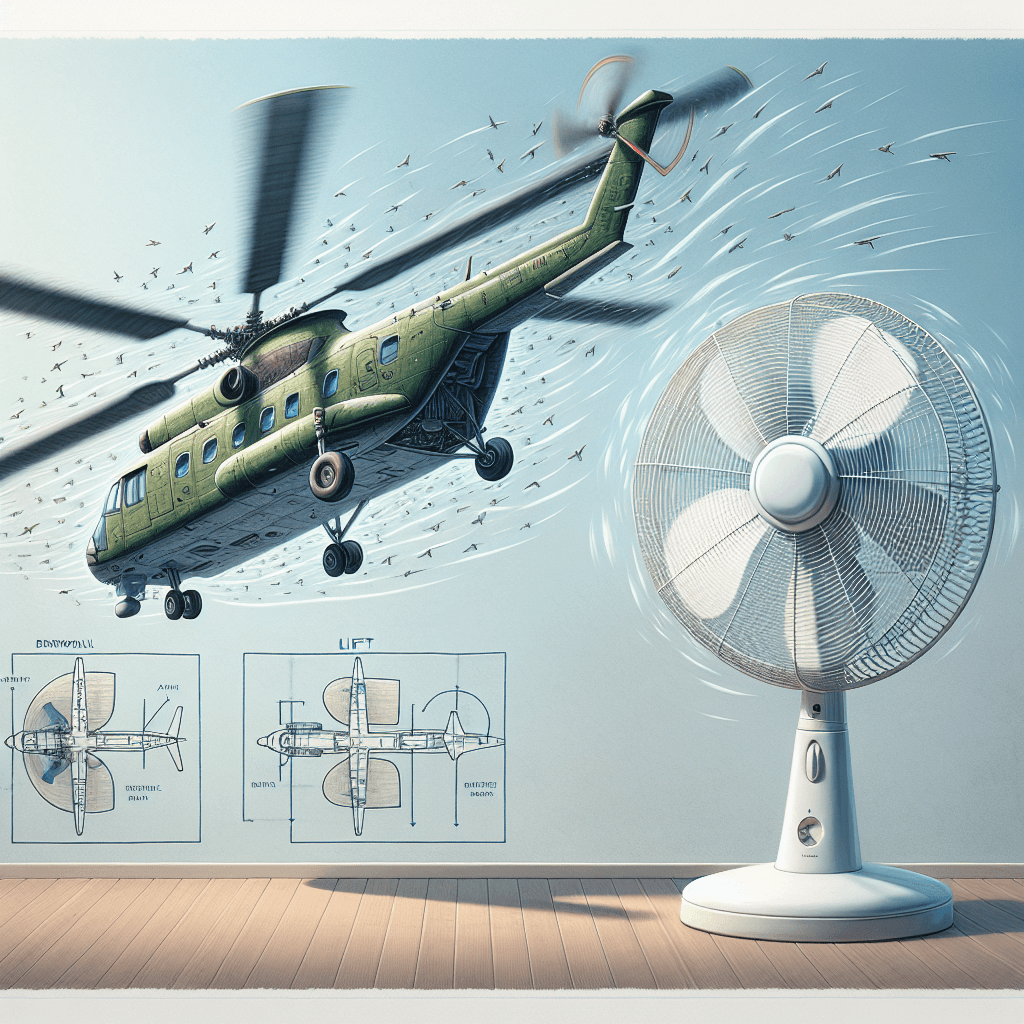Why can a helicopter fly with blades spinning slower than a simple house fan
It’s a mind-bending fact of physics: a helicopter’s massive blades spin slower than a simple house fan, yet they generate enough force to lift thousands of pounds. Uncover the incredible aerodynamic secret that makes this possible.


Too Long; Didn't Read
TLDR: Helicopter blades are giant, efficient wings that generate immense lift, while fan blades are small and just push air. Despite a low RPM, the tips of the long helicopter blades travel at hundreds of miles per hour, moving a massive amount of air to make the aircraft fly.
The Surprising Physics of Flight: Why Can a Helicopter Fly with Blades Spinning Slower Than a Simple House Fan?
It’s a common and curious observation. A simple house fan whirs at a dizzying speed, its blades a blurry circle, yet it can’t even lift itself off the table. Meanwhile, the massive blades of a multi-ton helicopter seem to rotate with an almost leisurely grace, yet they effortlessly lift the entire machine, its crew, and its cargo into the sky. This apparent contradiction isn't magic; it's a masterful display of aerodynamics and engineering. The answer to why a helicopter can fly with slower-spinning blades lies not in the rotational speed itself, but in fundamental differences in design, purpose, and the physics of how they interact with the air. This post will break down the key principles that allow these incredible machines to conquer gravity.
The Secret Isn't RPM, It's Aerodynamics
At its core, flight is about moving air. To generate lift, an aircraft must push a large mass of air downwards, and according to Newton's Third Law, the air pushes the aircraft upwards with an equal and opposite force. This is where the missions of a fan and a helicopter diverge completely.
- A House Fan's Job: To create a breeze. It's designed to move a relatively small volume of air horizontally at high velocity to make you feel cool. Its goal is airflow, not lift.
- A Helicopter's Job: To create lift. It is designed to move a massive volume of air downwards with enough force to overcome its own weight.
This fundamental difference in purpose dictates every aspect of their design, especially the blades.
The Airfoil Advantage: More Than Just a Flat Blade
Take a close look at a fan blade. It's typically a simple, slightly twisted piece of plastic or metal—essentially a paddle designed to push air.
Now, look at a helicopter's rotor blade. It isn't a flat paddle; it's a highly engineered airfoil. An airfoil is a structure with a specific shape, much like an airplane's wing—curved on the top and flatter on the bottom. As this shape cuts through the air, it forces the air traveling over the top to move faster than the air traveling underneath. According to Bernoulli's Principle, this faster-moving air creates a lower-pressure zone on top of the blade, while the slower air below maintains a higher pressure. This pressure differential generates a powerful upward force: lift. A fan blade, with its simple shape, generates almost no lift in this manner.
Size, Speed, and the Power of Pitch
While a helicopter's blades may have a lower RPM (Revolutions Per Minute) than a house fan, several other factors create an immense advantage.
Blade Size and Tip Speed
The sheer size of a helicopter's rotor system is a critical factor. While the RPM at the central hub might seem low (typically 250-500 RPM for a main rotor), the tips of the long blades are traveling at incredible speeds. For a helicopter with a 40-foot rotor diameter, a rotational speed of 400 RPM means the blade tips are slicing through the air at over 550 miles per hour—approaching the speed of sound! This high velocity is essential for generating significant lift. A small fan blade, even at 1,200 RPM, has a very low tip speed due to its short length.
The Power of Pitch Control
This is perhaps the most crucial difference. The blades on a house fan are fixed at a set angle. You can change their speed, but not their angle relative to the air they are pushing.
Helicopter blades, however, have a variable angle of attack, also known as "pitch." Using controls in the cockpit (the collective and cyclic sticks), a pilot can change the angle at which all the blades meet the oncoming air simultaneously.
- To take off or climb: The pilot increases the pitch, causing the blades to take a bigger "bite" of the air, generating more lift.
- To descend or hover: The pilot decreases the pitch, reducing lift.
This ability to change the angle of attack gives the helicopter precise control over lift without necessarily changing the rotor's RPM. A fan has no such capability; its only trick is to spin faster.
Helicopter vs. House Fan: A Tale of Two Blades
| Feature | Helicopter Rotor Blade | House Fan Blade | | :--- | :--- | :--- | | Purpose | Generate massive lift | Create a light breeze | | Shape | Aerodynamic airfoil | Simple, flat paddle | | Size | Very long (high tip speed) | Short (low tip speed) | | Control | Variable pitch (angle of attack) | Fixed angle | | Result| Powerful downward airflow | Gentle horizontal airflow |
Conclusion
The next time you see a helicopter in the sky, you can appreciate the brilliant engineering behind its seemingly slow-moving blades. The ability to fly isn't a simple matter of spinning fast. It's the result of a sophisticated system where airfoil design, massive blade length, and precise pitch control work in concert. A helicopter's blades are not just spinning; they are flying individually, each one a carefully shaped wing generating immense force. While a house fan is a simple tool for moving air, a helicopter's rotor system is a dynamic and powerful feat of physics that allows humanity to master the skies.
More Articles

What was the original purpose of the fluffy pom-pom on a traditional sailor's hat?
That fluffy ball on a sailor's hat wasn't just a cute decoration; it was a surprisingly simple tool designed to save them from a serious, and very common, occupational hazard.

Why do some pufferfish create intricate, beautiful sand circles on the ocean floor?
Mistaken for underwater crop circles, these mesmerizing patterns are actually the work of a tiny artist on the most elaborate and romantic quest in the entire ocean.

Why do some super cold drinks turn to slush the exact moment you open them?
It’s a bizarre and mesmerizing trick: a perfectly clear liquid that erupts into a frozen slush the exact moment you pop the top. Uncover the mind-bending physics that make this frosty magic happen.